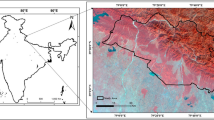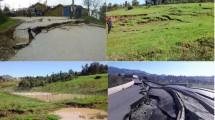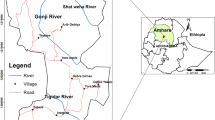Abstract
Landslides are one of the most common and damaging geological hazards that constrain the urban planning and development of many cities in northern Algeria. Therefore, landslide susceptibility maps (LSMs) constitute an essential tool for effective hazard management and long-term development planning in landslide-prone areas. The aim of this work is to prepare and compare the LSMs by applying GIS-based statistical and machine learning models for the new city of Sidi Abdellah and surrounding areas (Northern Algeria). We implemented the statistical models of the frequency ratio (FR), statistical index (SI), and weights of evidence (WoE) models, and the machine learning models represented by a logistic regression (LR) model for landslide susceptibility prediction. An historical landslide inventory map was produced using the interpretation of Google Earth satellite images, available historical records, and geological field investigations. The obtained landslides were randomly divided into the training (70%) and validation (30%) processes. Furthermore, 12 influencing factors for landslide occurrence (including precipitation, slope, elevation, distance to drainage, aspect, land use, density of streams, distance to road, lithology, distance to fault, seismicity, and density of roads) were selected to prepare thematic maps and were considered for susceptibility analysis. Subsequently, landslide susceptibility assessment and mapping are performed by considering the inventoried landslide events and their related predisposing factors using LR, SI, WoE, and FR models in GIS. The accuracy of the four models was verified, validated, and compared using the area under curve (AUC) value of the Receiver Operating Characteristics Curves (ROC) method. The validation results showed that all the used statistical models provided a good accuracy in predicting landslide susceptibility than the machine learning models, with the SI model having a higher AUC value of 80.1% than the WoE (78.2%), FR (78.2%), and LR (64.2%) models. Based on these results, we conclude that the established maps can be used as useful tools for land use planning and risk reduction in the urban area of Sidi Abdellah.















Similar content being viewed by others
Data availability
The corresponding author will provide data to back up the study’s findings upon a reasonable request.
References
ANRH, Agence Nationale des Ressources Hydrauliques (2005) Precipitation map performed from precipitation database from local meteorological stations located in the vicinity of the study area by using Kriging interpolation
Aymé A (1954) Service de la Carte Géologique de l'Algérie, Étude des terrains néogènes de la cluse du Mazafran:(Sahel d'Alger)
Bonham-Carter GF, Agterberg FP, Wright DF (1989) Weights of evidence modelling: a new approach to mapping mineral potential. In: Agterberg FP, Bonham-Carter GF (eds) Statistical applications in earth sciences. Geological Survey of Canada, Ottawa, pp 171–183
Bourenane H, Guettouche MS, Bouhadad Y, Braham M (2016) Landslide hazard mapping in the Constantine city, Northeast Algeria using frequency ratio, weights factor, logistic regression, weights of evidence, and analytical hierarchy process methods. Arab J Geosci 9:154. https://doi.org/10.1007/s12517-015-2222-8
CGS (2009) Centre National de Recherche Appliquée en Génie Parasismique. Seismic Microzonation study of the city of Sidi Abdellah. Unpublished Internal Report.
Chung CJF, Fabbri AG (2003) Validation of spatial prediction models for landslide hazard mapping. Nat Hazards 30:451–472. https://doi.org/10.1023/B:NHAZ.0000007172.62651.2b
Djerbal L, Khoudi I, Alimrina N, Melbouci B, Bahar R (2017) Assessment and mapping of earthquake-induced landslides in Tigzirt City, Algeria. Nat Hazards 87:1859–1879. https://doi.org/10.1007/s11069-017-2831-5
Goetz JN, Brenning A, Petschko H (2015) Evaluating machine learning and statistical prediction techniques for landslide susceptibility modeling. Comput Geosci 81:1–11. https://doi.org/10.1016/j.cageo.2015.04.007
Guirous L, Dubois L, Melbouci B (2014) Contribution à l’étude du mouvement de terrain de la ville de Tigzirt (Algérie). Bull Eng Geol Environ. https://doi.org/10.1007/s10064-014-0624-6
Guzzetti F, Carrara A, Cardinali M, Reichenbach P (1999) Landslide hazard evaluation: a review of current techniques and their application in a multi-scale study, Central Italy. Geomorphology 31:181–216. https://doi.org/10.1016/S0169-555X(99)00078-1
Hadji R, Boumazbeur A, Limani Y, Baghem M, Chouabi A, Demdoum A (2013) Geologic, topographic and climatic controls in landslide hazard assessment using GIS modeling: a case study of Souk Ahras region, NE Algeria. Quatern Int 302:224–237. https://doi.org/10.1016/j.quaint.2012.11.027
Hallal N, Dubois L, Bougdal R, Djouder F (2017) Instabilités gravitaires dans la région de Béjaïa (Algérie): Inventaire et appréciation de l’importance relative des différents paramètres conduisant au déclenchement, au maintien ou à l’activation des instabilités. Bull Eng Geol Environ. https://doi.org/10.1007/s10064-017-1050-3
Harbi A, Maouche S, Ayadi A, Benouar D, Panzag F, Benhallou H (2004) Seismicity and tectonic structures in the site of algiers and its surroundings: a step towards microzonation. Pure Appl Geophys 161(2004):949–967. https://doi.org/10.1007/s00024-003-2502-1
Huang F, Cao Z, Guo J, Jian SH, Li S, Guo Z (2020) Comparisons of heuristic, general statistical and machine learning models for landslide susceptibility prediction and mapping. CATENA 191:104580. https://doi.org/10.1016/j.catena.2020.104580
Huang J, Wu X, Ling S, Li X, Wu Y, Peng L, He Z (2022) A bibliometric and content analysis of research trends on GIS-based landslide susceptibility from 2001 to 2020. Environ Sci Pollut Res 29:86954–86993. https://doi.org/10.1007/s11356-022-23732-z
Karim Z, Hadji R, Hamed Y (2019) GIS based approaches for the landslide susceptibility prediction in Setif Region (NE Algeria). Geotech Geol Eng 37(1):359–374. https://doi.org/10.1007/s10706-018-0615-7
Koica (2003) Master Plan project of the city of Sidi Abdellah established by KOREA International Cooperation Agency (KOICA). Unpublished Internal Report
Lani J (2007) Generalized linear models. Organ. Res. Methods 7:127-150
Laribi A, Walstra J, Ougrine M, Seridi A, Dechemi N (2014) Use of digital photogrammetry for the study of unstable slopes in urban areas: Case study of the El Biar landslide. Algiers Eng Geol 187(2015):73–83. https://doi.org/10.1016/j.enggeo.2014.12.018
Lee S, Min K (2001) Statistical analysis of landslide susceptibility at Yongin, Korea. Eng Geol 40:1095–1113. https://doi.org/10.1007/s002540100310
Lee S, Pradhan B (2007) Landslide hazard mapping at Selangor, Malaysia using frequency ratio and logistic regression models. Landslides 4:33–41. https://doi.org/10.1007/s10346-006-0047-y
Meghraoui M (1988) Géologie des zones sismiques du Nord de l’Algérie : Paleosismologie, tectonique active et synthèse sismotectonique. Thèse de Doctorat, spécialité Sciences Naturelles, mention Géologie Structurale, Université de Paris Sud, Centre Orsay N°.3495 Paris le 23 juin 1988.
Merghadia A, Yunusb AP, Douc JD, Whiteleye J, Thai Phamg B, Tien Buihn B, Avtari R, Boumezbeur A (2020) Machine learning methods for landslide susceptibility studies : A comparative overview of algorithm performance. Earth-Sci Rev. https://doi.org/10.1016/j.earscirev.2020.103225
Mohammady M, Pourghasemi HR, Pradhan B (2012) Landslide susceptibility mapping at Golestan Province Iran: a comparison between frequency ratio, Dempster-Shafer, and weights-of evidence models. J Asian Earth Sci 61:221–236. https://doi.org/10.1016/j.jseaes.2012.10.005
Moulouel H, Bouchelouh A, Bensalem R, Tebbouche MY, Ait Benamar D, Oubaiche E, Gharbi S, Machane D, Benamghar A (2020) The Mahelma fault: a secondary structure of the Sahel anticline? Arab J Geosci 13:715. https://doi.org/10.1007/s12517-020-05694-z
Nourani V, Pradhan B, Ghaffari H, Sharifi SS (2014) Landslide susceptibility mapping at Zonouz Plain, Iran using genetic programming and comparison with frequency ratio, logistic regression, and artificial neural network models. Nat Hazards 71:523–547. https://doi.org/10.1007/s11069-013-0932-3
Ozdemir A, Altural T (2012) A comparative study of frequency ratio, weights of evidence and logistic regression methods for landslide susceptibility mapping: Sultan Mountains SW Turkey. J Asian Earth Sci 2:2. https://doi.org/10.1016/j.jseaes.2012.12.014
Park S, Choi C, Kim B (2013) Landslide susceptibility mapping using frequency ratio, analytic hierarchy process, logistic regression, and artificial neural network methods at the Inje area. Korea Environ Earth Sci 68:1443–1464. https://doi.org/10.1007/s12665-012-1842-5
Pourghasemi HR, Moradi HR, Fatemi Aghda SM (2013) Landslide susceptibility mapping by binary logistic regression, analytical hierarchy process, and statistical index models and assessment of their performances. Nat Hazards 69:749–779. https://doi.org/10.1007/s11069-013-0728-5
Pradhan B, Lee S (2010a) Landslide susceptibility assessment and factor effect analysis: backpropagation artificial neural networks and their comparison with frequency ratio and bivariate logistic regression modelling. Environ Model Softw 25:747–759. https://doi.org/10.1016/j.envsoft.2009.10.016
Pradhan B, Lee S (2010b) Regional landslide susceptibility analysis using back-propagation neural network model at Cameron Highland, Malaysia. Landslides 7:13–30. https://doi.org/10.1007/s10346-009-0183-2
Pradhan B, Youssef A (2010) Manifestation of remote sensing data and GIS on landslide hazard analysis using spatial-based statistical models. Arab J Geosci 3:319–326. https://doi.org/10.1007/s12517-009-0089-2
Regmi AD, Yoshida K, Pradhan B, Pourghasemi HR, Khumamoto T, Akgun A (2014) Application of frequency ratio, statistical index and weights-of-evidence models, and their comparison in landslide susceptibility mapping in Central Nepal Himalaya. Arab J Geosci 7(2):725–742. https://doi.org/10.1007/s12517-012-0807-z
Rodgers JL, Nicewander WA (1988) Thirteen ways to look at the correlation coefficient. Am Stat 42(1):59–66
Sahana M, Pham BT, Shukla M, Costache R, Thu D, Chakrabortty R, Satyam N, Nguyen HD, Phong TV, Le HV, Pal SC, Areendran G, Imdad K, Prakash I (2020) Rainfall induced landslide susceptibility mapping using novel hybrid soft computing methods based on multi-layer perceptron neural network classifier. Geocarto Int 37:2747–2771. https://doi.org/10.1080/10106049.2020.1837262
Thiery Y, Malet JP, Sterlacchini S, Puissant A, Maquaire O (2007) Landslide susceptibility assessment by bivariate methods at large scales: application to a complex mountainous environment. Geomorphology 92(1–2):38–59. https://doi.org/10.1016/j.geomorph.2007.02.020
Tien Bui D, Lofman O, Revhaug I, Dick O (2011) Landslide susceptibility analysis in the Hoa Binh province of Vietnam using statistical index and logistic regression. Nat Hazards 59:1413–1444. https://doi.org/10.1007/s11069-011-9844-2
Varnes DJ (1978) Slope movement, types and processes. In: Schuster RL, Krizek RJ (Eds) Landslides, analyses and control. National Academy of Science, Report 176, Washington, DC, pp 11–35.
Van Westen CJ (1997) Statistical landslide hazard analysis. ILWIS 2.1 for Windows application guide. ITC publication, Enschede, The Netherlands, pp 73–84.
Xiao T, Yin K, Yao T, Yin K (2019) Spatial prediction of landslide susceptibility using GIS-based statistical and machine learning models in Wanzhou County, Three Gorges Reservoir, China. Acta Geochim 38:654–669. https://doi.org/10.1007/s11631-019-00341-1
Yalcin A (2008) GIS-based landslide susceptibility mapping using analytical hierarchy process and bivariate statistics in Ardesen (Turkey): comparisons of results and confirmations. CATENA 72(1):1–12. https://doi.org/10.1016/j.catena.2007.01.003
Yesilnacar E, Topal T (2005) Landslide susceptibility mapping: a comparison of logistic regression and neural networks methods in a medium scale study, Hendek region (Turkey). Eng Geol 79(3–4):251–266. https://doi.org/10.1016/j.enggeo.2005.02.002
Yılmaz I (2009) Landslide susceptibility mapping using frequency ratio, logistic regression, artificial neural networks and their comparison: a case study from Kat landslides (Tokat-Turkey). Comput Geosci 35(6):1125–1138
Zhou G, Esaki T, Mitani Y, Xie M, Mori J (2003) Spatial probabilistic modeling of slope failure using an integrated GIS Monte Carlo simulation approach. Eng Geol 68:373–386
Zhou S, Zhang Y, Tan X, Abbas SM (2021) A comparative study of the bivariate, multivariate and machine-learning-based statistical models for landslide susceptibility mapping in a seismic-prone region in China. Arab J Geosci 14:440. https://doi.org/10.1007/s12517-021-06630-5
Acknowledgements
This research is supported by the National Center for Applied Research in Earthquake Engineering (CGS). We thank everyone who provided assistance in the process of conducting this research. We are grateful to the local authorities and residents of Sidi Abdallah municipality for their invaluable assistance in the field. The authors are grateful to the Editor-in-Chief of the Modeling Earth Systems and Environment (MESE) journal and to the anonymous reviewer for their valuable time and comments, which led to the improvement of an early version of this manuscript.
Funding
This research did not receive any specific grant from funding agencies in the public, commercial, or not-for-profit sectors.
Author information
Authors and Affiliations
Corresponding author
Ethics declarations
Conflict of interests
The author have no competing interests to declare that are relevant to the content of this article.
Consent to participate
All authors have given their consent for their research to be published in this journal.
Additional information
Publisher's Note
Springer Nature remains neutral with regard to jurisdictional claims in published maps and institutional affiliations.
Rights and permissions
Springer Nature or its licensor (e.g. a society or other partner) holds exclusive rights to this article under a publishing agreement with the author(s) or other rightsholder(s); author self-archiving of the accepted manuscript version of this article is solely governed by the terms of such publishing agreement and applicable law.
About this article
Cite this article
Hamid, B., Massinissa, B. & Nabila, G. Landslide susceptibility mapping using GIS-based statistical and machine learning modeling in the city of Sidi Abdellah, Northern Algeria. Model. Earth Syst. Environ. 9, 2477–2500 (2023). https://doi.org/10.1007/s40808-022-01633-x
Received:
Accepted:
Published:
Issue Date:
DOI: https://doi.org/10.1007/s40808-022-01633-x




